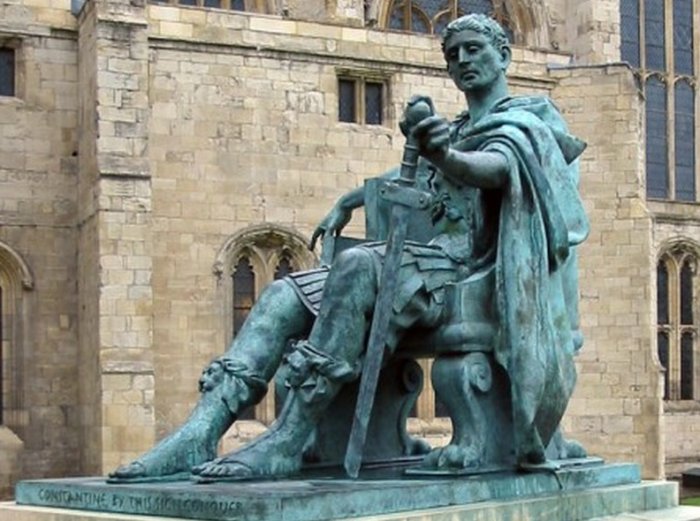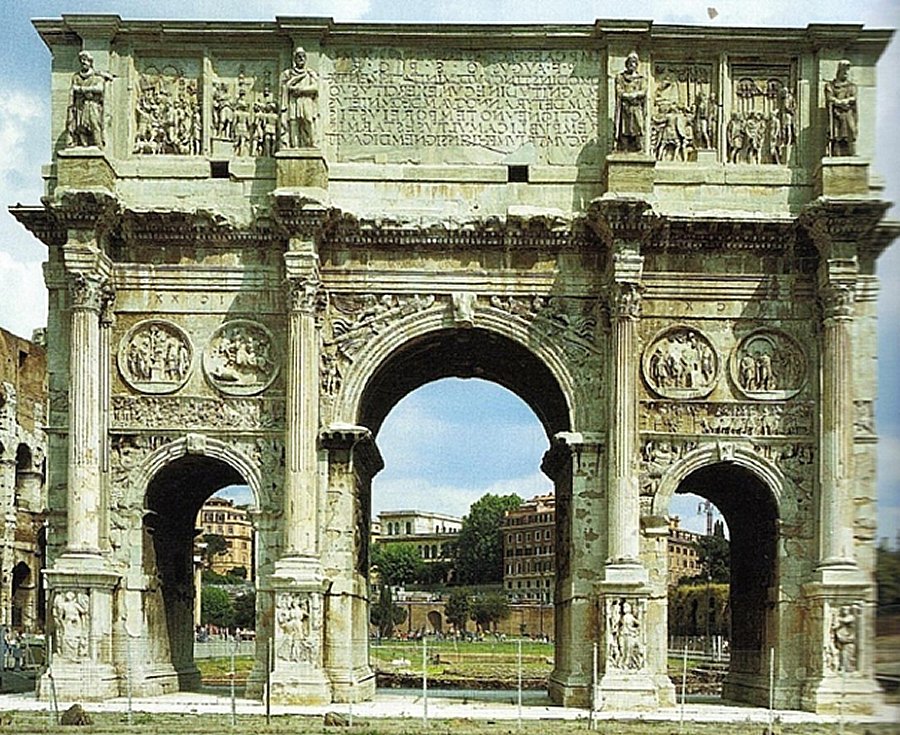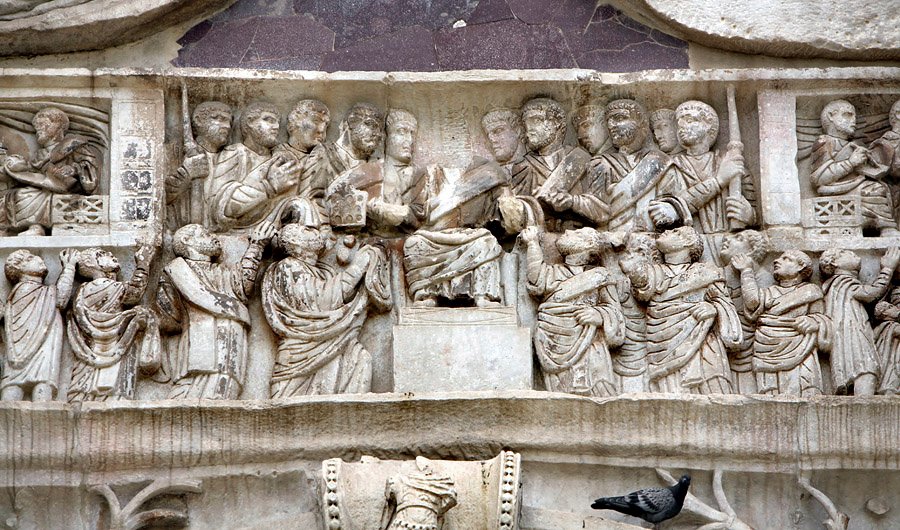Triumphal Arch Of Roman Emperor Constantine And His Great Vision
A. Sutherland - AncientPages.com - Roman imperial triumphal arches symbolized the empire's power and greatness of the emperor. The arches were decorated with beautiful historical scenes commemorating the achievements of the Roman leader to his people and the kingdom.
Credit: Adobe Stock - Sergii Figurnyi
Republican tradition meant that the arches were closely associated with an individual's achievements. During the imperial period, emperors used arches to convey information about their military and civil achievements.
The Arch of Constantine, Rome - situated in the vicinity of the Colosseum in Rome - is a monument to the glory of Emperor Constantine the Great. It represented the largest preserved Roman Arch and was exhibited on July 25, 315 AD, in Rome to commemorate the tenth anniversary of Constantine's rule (decennalia) and his great victory at the Battle of Ponte Milvio in 312 AD.
Constantine conquered his great rival for power, Emperor Maxentius, who had co-ruled with him between 306 and 312 AD, before being expelled.
Who Was Constantine The Great?
The emperor Constantine is celebrated as a saint in the Orthodox Church but not in the Western Church.
After the battle of Mulvian Bridge on October 27, 312 AD, Flavius Valerius Aurelius Constantinus became the emperor of Rome commonly known as Constantine the Great.
From a Christian perspective, his most outstanding merit was the legalization of Christianity. He also moved the imperial capital to Constantinople.
Ancient chronicles say that Emperor Constantine had a vision that God promised him a victory if his army portrayed the sign of the cross on their shields.
Fourth-century historian and bishop Eusebius of Caesarea wrote in "The Life of the Blessed Emperor Constantine" about Constantine's experience:
 The vision of Emperor Constantine. Credits: P. Rubens
The vision of Emperor Constantine. Credits: P. Rubens
"The emperor said that about the noon hour, when the day was already beginning to wane, he saw with his own eyes in the sky above the sun a cross composed of light, and that there was attached to it an inscription saying, "By this conquer." At the sight, he said, astonishment seized him and all the troops who were accompanying him on the journey and were observers of the miracle.
He said, moreover, that he doubted within himself what the import of this apparition could be, And while he continued to ponder and reason on its meaning, night suddenly came on; then in his sleep, the Christ of God appeared to him with the same sign which he had seen in the heavens and commanded him to make a likeness of that sign which he had seen in the heavens, and to use it as a safeguard in all engagements with his enemies.
Arch of Constantine, Rome. Image credit: Alexander Z - CC BY-SA 3.0
At dawn of day, he arose and communicated the marvel to his friends; and then, calling together the workers in gold and precious stones, he sat in the midst of them and described to them the figure of the sign he had seen, bidding them represent it in gold and precious stones…"
Constantine did conquer Maxentius, and the battle marked the beginning of Constantine's conversion to Christianity. He also reformed the army, stabilized the economy in the empire, and introduced the solidus. This gold coin continued in the Byzantine Empire and remained used for a thousand years.
Impressive Arch of Constantine In Full Glory But Decorated With Old Reliefs
 Above: Battle of Ponte Milvio in 312 AD: Below: Siege of Verona 312 AD.
Above: Battle of Ponte Milvio in 312 AD: Below: Siege of Verona 312 AD.
The monumental triumphal Arch of Constantine stands 21m high, 25.7m wide, and 7.4m deep. Undoubtedly, the structure is attributed to Constantine's divine inspiration, and this experience could help him win the battle.
However, the Arch does not display visible Christian symbols.
On the contrary, all reliefs that decorate the monument were taken from monuments made for earlier Roman emperors. These reliefs were once dedicated to other great emperors such as Trajan, Hadrian, and Marcus Aurelius, known for their best achievements dating to the 2nd century when the Roman Empire flourished.
A detail of the northern frieze of the Arch of Constantine. This detail shows Constantine distributing gifts from his throne down to his supporters. Credits: commons.wikimedia.org/
Many historians have long wondered why new decorative elements are missing in the Arch of Constantine.
Was it because artists and builders did not have new fresh ideas to use, or was it better to keep the same older style to show that Constantine's status, legitimacy, and achievements were equal to some other the best Roman emperors?
Written by – A. Sutherland - AncientPages.com Senior Staff Writer
Updated on September 17, 2022
Copyright © AncientPages.com All rights reserved. This material may not be published, broadcast, rewritten or redistributed in whole or part without the express written permission of AncientPages.com
Expand for referencesMore From Ancient Pages
-
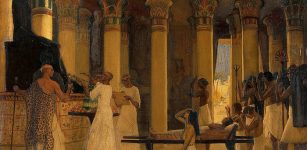 Egyptians Mastered Medicine Thousands Of Years Ago
Civilizations | Oct 1, 2015
Egyptians Mastered Medicine Thousands Of Years Ago
Civilizations | Oct 1, 2015 -
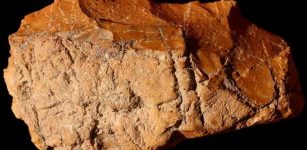 Traces Of Early Humans Discovered In Southern Iran
Archaeology | Sep 25, 2019
Traces Of Early Humans Discovered In Southern Iran
Archaeology | Sep 25, 2019 -
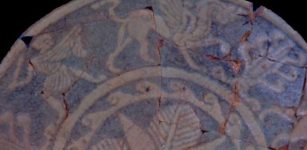 Scientists Reveal What Egyptian Faience Have To Do With Gold
Archaeology | Dec 17, 2022
Scientists Reveal What Egyptian Faience Have To Do With Gold
Archaeology | Dec 17, 2022 -
 Mysterious Object In Asuka – The Place Of ‘Flying Birds’
Civilizations | Aug 11, 2018
Mysterious Object In Asuka – The Place Of ‘Flying Birds’
Civilizations | Aug 11, 2018 -
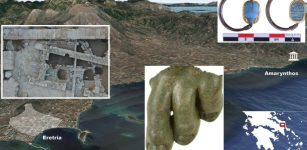 Sanctuary Of Amarysia Artemis, Amarynthos – New Valuable Finds By Greek-Swiss Team
Archaeology | Sep 26, 2022
Sanctuary Of Amarysia Artemis, Amarynthos – New Valuable Finds By Greek-Swiss Team
Archaeology | Sep 26, 2022 -
 Unusual Neolithic Burial From Grotta Di Pietra Sant’ Angelo Puzzles Archaeologists
Featured Stories | Jan 15, 2024
Unusual Neolithic Burial From Grotta Di Pietra Sant’ Angelo Puzzles Archaeologists
Featured Stories | Jan 15, 2024 -
 Silla: The Most Successful Of Three Korean Kingdoms
Featured Stories | Aug 22, 2023
Silla: The Most Successful Of Three Korean Kingdoms
Featured Stories | Aug 22, 2023 -
 Ancient Pottery Reveal How Peru’s First Great Empire Wari Functioned
Archaeology | Mar 14, 2023
Ancient Pottery Reveal How Peru’s First Great Empire Wari Functioned
Archaeology | Mar 14, 2023 -
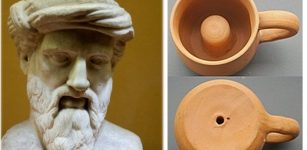 Pythagorean Cup Was A Practical Joke To Punish Greedy Drinkers And It Still Fools People
Ancient History Facts | Dec 18, 2020
Pythagorean Cup Was A Practical Joke To Punish Greedy Drinkers And It Still Fools People
Ancient History Facts | Dec 18, 2020 -
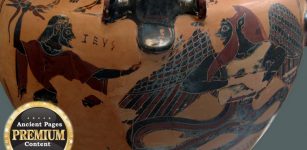 Mysterious Shape-Shifting Beings In Ancient Greece
Ancient Mysteries | Nov 12, 2014
Mysterious Shape-Shifting Beings In Ancient Greece
Ancient Mysteries | Nov 12, 2014 -
 Beware Of The Shapeshifting Gaelic Bodach Who May Be Difficult To Trick
Christmas Traditions | Dec 20, 2024
Beware Of The Shapeshifting Gaelic Bodach Who May Be Difficult To Trick
Christmas Traditions | Dec 20, 2024 -
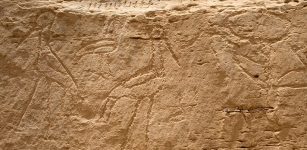 Unknown Rock Inscriptions And Earliest Monumental Hieroglyphs In Egypt Shed New Light On Ancient Writing
Archaeology | Jun 27, 2017
Unknown Rock Inscriptions And Earliest Monumental Hieroglyphs In Egypt Shed New Light On Ancient Writing
Archaeology | Jun 27, 2017 -
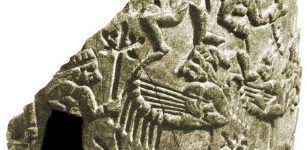 Lugal-Anne-Mundu: ‘King Of The Universe’ And Powerful Leader Who Restored Sumer To Its Former Glory
Civilizations | Oct 1, 2016
Lugal-Anne-Mundu: ‘King Of The Universe’ And Powerful Leader Who Restored Sumer To Its Former Glory
Civilizations | Oct 1, 2016 -
 Mysterious 210,000-Year-Old Apidima Skull Could Re-Write Human History
Archaeology | Jul 11, 2019
Mysterious 210,000-Year-Old Apidima Skull Could Re-Write Human History
Archaeology | Jul 11, 2019 -
 Why Did Ancient Humans Have Same Sense Of Smell, But Different Sensitivities?
Archaeology | Jan 6, 2023
Why Did Ancient Humans Have Same Sense Of Smell, But Different Sensitivities?
Archaeology | Jan 6, 2023 -
 On This Day In History: Battle Of King’s Mountain Was Fought – On Oct 7, 1780
News | Oct 7, 2016
On This Day In History: Battle Of King’s Mountain Was Fought – On Oct 7, 1780
News | Oct 7, 2016 -
 Shipboard Cannon Found On The Swedish West Coast May Be Europe’s Oldest!
Archaeology | Sep 12, 2023
Shipboard Cannon Found On The Swedish West Coast May Be Europe’s Oldest!
Archaeology | Sep 12, 2023 -
 Why Human Languages Can Be Likened To Branches On A Tree And Help Finding A Single Common Ancestor
Linguistic Discoveries | Sep 11, 2021
Why Human Languages Can Be Likened To Branches On A Tree And Help Finding A Single Common Ancestor
Linguistic Discoveries | Sep 11, 2021 -
 Interesting Relief Sculpture Of Pharaoh Hatshepsut Found At Swansea University
Archaeology | Mar 27, 2018
Interesting Relief Sculpture Of Pharaoh Hatshepsut Found At Swansea University
Archaeology | Mar 27, 2018 -
 LIDAR Will ‘Map’ The Ground Surface To Reveal New Picture Of Ancient Native American Culture
Archaeology | Aug 18, 2023
LIDAR Will ‘Map’ The Ground Surface To Reveal New Picture Of Ancient Native American Culture
Archaeology | Aug 18, 2023


